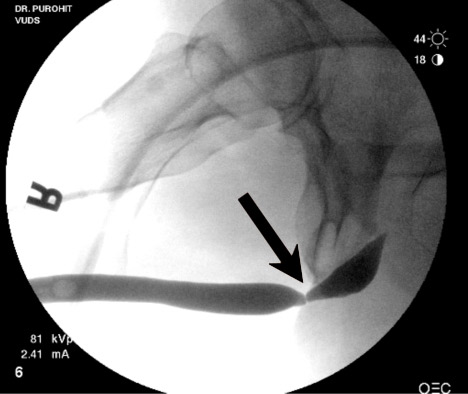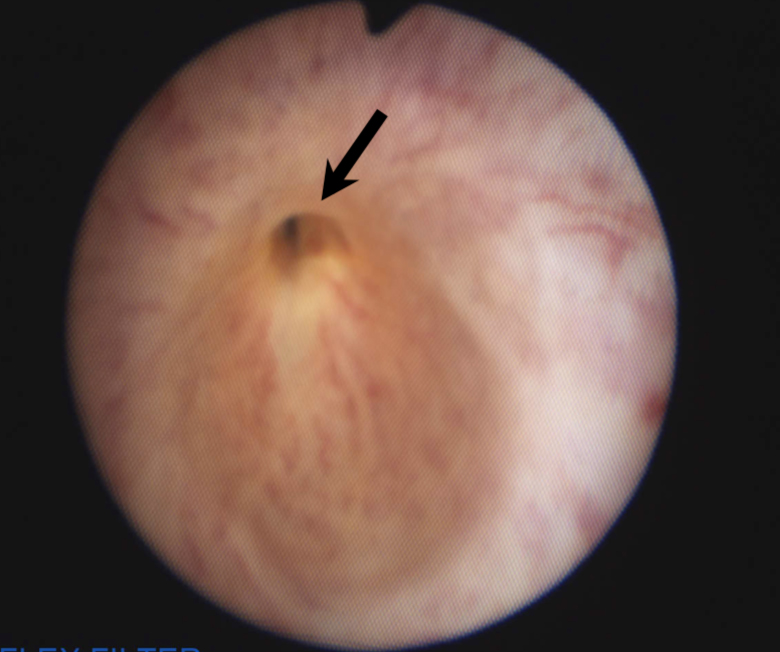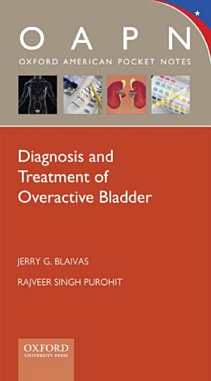Diagnosis of Urethral Stricture
What is the urethra?
The urethra is the tube or channel that carries urine from the bladder to the tip of the penis. The tube runs through the prostate gland and the bottom of the penis before emerging at the end of the penis.
What is a urethral stricture?
A urethral stricture is a narrowing of the lining of the urethra.
| On this X-ray, called a retrograde urethrogram, dye is injected into the urethra, which looks like a tube and appears dark gray. The stricture is the sharp narrowing in the tube where the arrow is located. |
If you look inside the urethra (with a cystoscope) you would see an abrupt narrowing in the lining of the urethra. This is a picture of someone who was diagnosed with a urethral stricture. This narrowing is the urethral stricture and the arrow points to it. |
 |
 |
What causes urethral strictures? How did I get a urethral stricture?
Typical causes of a urethral stricture include trauma, either from an injury, such as a car or bike accident, complications from a medical procedure such as a urethral catheter placement or from prostate surgery. Occasionally, an infection of the urethra or gonorrhea (a sexually transmitted disease) can cause this, but in many cases the cause of the stricture is unknown.
What are the symptoms of a urethral stricture?
The most common symptoms of a urethral stricture are related to problems urinating. Typically you might have a very slow urinary stream, need to push to urinate, not completely empty your bladder and feeling like you have to urinate again after urinating or have urinary frequency and strong urges to urinate. Other symptoms include pain, bleeding and a fear of urinating.
What kind of problems can a urethral stricture cause?
A urethral stricture can cause permanent bladder damage, recurrent urinary tract infections, blood in the urine, backup of urine to the kidneys and kidney damage. It is also very uncomfortable for patients and makes patients think about urinating often and fear having to go to the bathroom.
How do you diagnose a urethral stricture? What kind of evaluation will I need?
Usually patients present with suspicious urinary symptoms and difficulty urinating. The urologist might see a slow urinary flow on a machine that tests or see a high residual urine in the bladder after urination. The gold standard for diagnosis is a cystoscopy where a small scope is used to look inside the urethra under local anesthesia. A retrograde urethrogram is an x-ray study where contrast dye is placed in the urethra to mark out its borders and find the location and length of the stricture is also very helpful to evaluate the stricture.
I have a urethral stricture, what should I do?
First, learn as much as you can about your options. Second, find a urologist who is expert and experienced in reconstructive surgery and urethral stricture disease. Be sure to ask the doctor if he is an expert; if not, ask him to recommend someone who is. A generalist urologist may not know about the best options for you; there is nothing to lose and much to gain by getting a second opinion.
Your best chance for a cure is the first time you get treated, but this often requires an operation under general anesthesia. If you are too unhealthy and do not want to undergo surgery, management with dilations would be ok, but if you want to cure your problem, surgery is usually necessary.
Is the Urocenter experienced with strictures?
We have one of the world’s busiest reconstructive practices specializing in both male and female reconstruction. We have combined experience of over 30 years successfully treating cases other urologists have given up on and have the rare combination of efficacy of cutting edge techniques with the reassurance of experience.
We evaluate and treat not only those with straightforward “run-of-the mill” strictures but also complex strictures such as those that occupy the entire length of the urethra, strictures caused by radiation and recurrent strictures after Urolume insertion, and even urethral strictures in women. We have pioneered techniques to deal with radiation strictures, female strictures and have also utilized state-of-the-art technology such as robotic surgery to revolutionize treatment of complex strictures. We often see patients referred by other urologists who come to us as a last resort and we offer the best chance of definitive cure for these difficult to treat patients. But remember, the best chance for cure is the first operation and the Urocenter of New York may offer you your best chance to cure this problem.
—–
Why Choose a Uro Center Urologist in New York?
The urologists at the Uro Center in New York are experts in their field, bringing academic and research based innovation to the clinical forefront. Our urology team specializes in areas of treatment such as: robotic surgery, reconstructive urology, men’s health & infertility, kidney stones, urologic oncology, penile implant surgery, urethral stricture, BPH, Urinary incontinence treatment, Mesh complications, Enlarged prostate treatment, Urodynamics, vesicovaginal fistula and female incontinence in New York.
Request an Appointment











